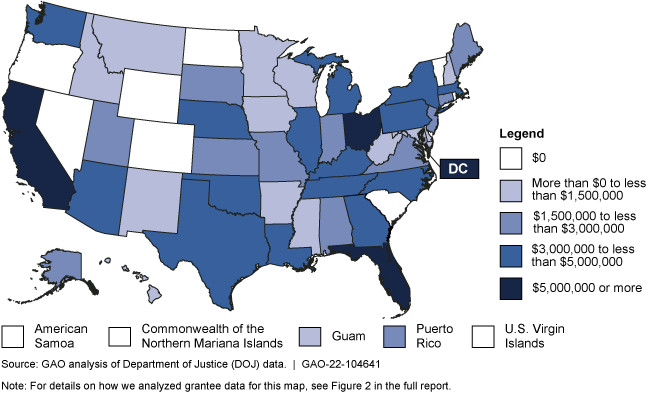Second Chance Reentry Grants: DOJ Should Report Limitations When Publishing Performance Data
Fast Facts
Department of Justice "Second Chance" grants help nonprofits and state and local agencies deliver services—like employment and housing assistance—to individuals reentering society after serving a prison sentence.
Grantees report data to DOJ—like how many program participants found jobs and housing after release. DOJ has published such data to highlight program successes and justify budgets, but didn't note other factors that could have influenced participants' success or what conclusions, if any, can be drawn about program effectiveness from the data.
We recommended that DOJ ensure its reports clearly identify performance data limitations.
Second Chance Reauthorization Act of 2018 Grant Awards, by Location, Fiscal Years 2019 to 2020.

Highlights
What GAO Found
The Department of Justice (DOJ) awarded $136 million in grants from fiscal years 2019 to 2020 to entities that assist individuals reentering society after serving their prison sentence under the Second Chance Reauthorization Act of 2018. Specifically, DOJ awarded 144 grants to entities such as state and local governments and nonprofit organizations (see figure below). Grantees are to use funds to deliver services (e.g., employment and housing assistance), build local partnerships, and evaluate the effectiveness of their programs.
Second Chance Reauthorization Act of 2018 Grant Awards, by Grantee Type, Fiscal Years 2019 to 2020

DOJ has two approaches to evaluate the effectiveness of the reentry grants on individuals' success at reentering the community and avoiding recidivism. First, DOJ is funding an evaluation designed to provide evidence of the effectiveness of three selected grantees. Second, some grantees are required to evaluate their programs, and others may choose to do so. However, grantees have latitude in some cases to determine the type and focus of their evaluation. Generally, these evaluations are due after the grant period ends, and it is too soon to know what these evaluations will show regarding grant effectiveness, according to DOJ.
Second Chance grantees are generally required to submit performance data to DOJ, and DOJ has published the data it received in congressional budget justifications and grant program fact sheets that GAO reviewed. However, DOJ did not identify limitations of the data or discuss what conclusions could or could not be drawn from the data in these products. DOJ has previously stated that these performance data cannot be used as evidence of the effectiveness of Second Chance grant programs. Taking steps to identify limitations of the data in published documents, consistent with leading practices for transparently reporting performance information, would provide the necessary context for Congress and other readers to appropriately interpret the information and make informed decisions about Second Chance grant programs.
Why GAO Did This Study
More than 600,000 individuals were released from U.S. prisons in 2019 after serving their sentences. DOJ awards grants to organizations that assist these individuals in obtaining employment, housing, and mental health treatment, among other services.
The Second Chance Reauthorization Act of 2018 includes a provision for GAO to review DOJ's reentry grants. This report (1) describes Second Chance Reauthorization Act grants awarded by DOJ from fiscal years 2019 to 2020, (2) examines steps that DOJ is taking to evaluate the effectiveness of these grants, and (3) describes the reentry grant performance data that DOJ reported in products shared with external parties and assesses whether DOJ disclosed any limitations of the data.
GAO analyzed DOJ data and documents (e.g., grant solicitations) related to reentry grants awarded in fiscal years 2019 and 2020. GAO also interviewed agency officials to discuss performance data and evaluation planning. GAO interviewed representatives from a nongeneralizable sample of eight grantees. The sample was selected based on factors including organization type (e.g., state government agencies or nonprofit organizations) and population served.
Recommendations
GAO recommends that DOJ ensure that published products that include Second Chance Reauthorization Act performance data clearly identify the limitations of those data. DOJ concurred with the recommendation.
Recommendations for Executive Action
| Agency Affected | Recommendation | Status |
|---|---|---|
| Department of Justice | The Attorney General should ensure published products that include Second Chance Reauthorization Act of 2018 performance data clearly identify the limitations of those data. (Recommendation 1) |
The Department of Justice (DOJ) concurred with our recommendation that published DOJ products that include Second Chance Reauthorization Act performance data clearly identify the limitations of the data. In January 2024, DOJ provided two examples of published reports that included language discussing that the data should be interpreted with caution, that they do not represent evidence of program effectiveness, and that other factors than program participation may have influenced participant outcomes. As a result, readers such as Congress and the public will better understand what is known about the effectiveness of DOJ's reentry grant programs and the potential challenges the agency faces in aiding individuals' reentry into society after incarceration.
|
